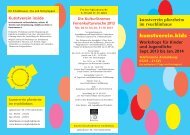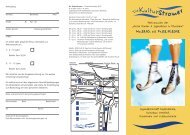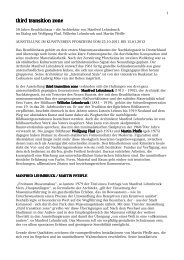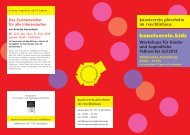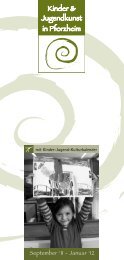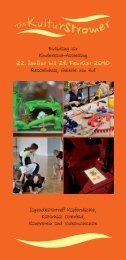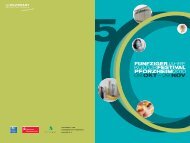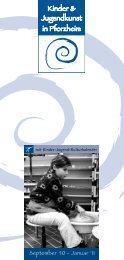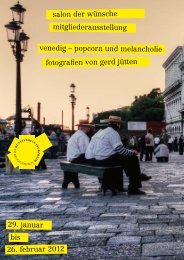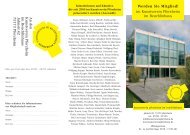Flyer - Kunstverein Pforzheim im Reuchlinhaus eV
Flyer - Kunstverein Pforzheim im Reuchlinhaus eV
Flyer - Kunstverein Pforzheim im Reuchlinhaus eV
Erfolgreiche ePaper selbst erstellen
Machen Sie aus Ihren PDF Publikationen ein blätterbares Flipbook mit unserer einzigartigen Google optimierten e-Paper Software.
Schöne Aussichten?<br />
Landschaft <strong>im</strong> Schmuck<br />
Ansichtssache Landschaft<br />
Landschaft: Wir erleben sie um uns,<br />
genauso wie sie in uns wirkt. Wir machen<br />
uns vielfältige Bilder von ihr. Zeittypische<br />
Vorstellungen von Landschaft<br />
manifestieren sich in vielfältigen Medien,<br />
sei es <strong>im</strong> Kino, auf Postkarten und Urlaubsfotos,<br />
als Kulturlandschaft oder Naturschutzgebiet,<br />
Parkanlage oder Ausflugsziel.<br />
Im Schmuck und in der bildenden Kunst<br />
ist Landschaft zum eigenständigen Thema<br />
geworden. Die Ausstellungen »Schöne Aussichten?<br />
Landschaft <strong>im</strong> Schmuck« und<br />
»Ansichtssache Landschaft« in Schmuckmuseum<br />
und <strong>Kunstverein</strong> <strong>Pforzhe<strong>im</strong></strong> <strong>im</strong><br />
<strong>Reuchlinhaus</strong> nähern sich diesem vertrauten<br />
und doch <strong>im</strong>mer wieder neuen Genre aus<br />
historischer und zeitgenössischer Perspektive.<br />
medaillon-anhänger<br />
gold, email, glas<br />
alexis falize, paris, ca. 1869<br />
Magnificent Views?<br />
Landscapes in Jewellery<br />
Landscapes –<br />
a Matter of Perspectives<br />
Landscapes: we are surrounded by them,<br />
experience them, and they have an effect<br />
on us. We form a multitude of landscape<br />
<strong>im</strong>ages in our mind’s eye, and notions of<br />
landscapes typical of a certain era manifest<br />
themselves in a variety of media<br />
such as in movies, on postcards and holiday<br />
photos, in the form of cultured landscapes,<br />
nature reserves, parks or excursion<br />
destinations. In jewellery as well as in<br />
the fine arts, landscapes have evolved as<br />
an autonomous theme. The ›Magnificent<br />
Views? – Landscapes in Jewellery‹ and ›Landscapes,<br />
a Matter of Perspectives‹ exhibitions<br />
organized by <strong>Pforzhe<strong>im</strong></strong>’s Jewellery Museum<br />
and the city’s Art Association in the<br />
<strong>Reuchlinhaus</strong> building explore this familiar<br />
yet always novel genre from both a historical<br />
and a contemporary angle.<br />
o. T.<br />
styropor, le<strong>im</strong>, farbe, lackspray<br />
gesine grundmann, 2005<br />
courtesy galerie vera gliem, köln<br />
Schöne Aussichten?<br />
Landschaft <strong>im</strong> Schmuck<br />
taschenuhr<br />
gehäuse silber, emailliertes ziffernblatt<br />
pforzhe<strong>im</strong>, frühes 19. jh.<br />
Landschaft – eine Entdeckung<br />
Als eigenständiges Thema musste Landschaft<br />
erst entdeckt werden, sie tritt nur<br />
zaghaft ins Bild - nicht nur in der Malerei,<br />
sondern auch <strong>im</strong> Schmuck. Von der symbolischen<br />
Andeutung bei mittelalterlichen<br />
Heiligendarstellungen bis zum lieblichen<br />
Idyll antiker Szenen <strong>im</strong> Barock bleibt<br />
sie zunächst <strong>im</strong> Hintergrund.<br />
Allmählich werden <strong>im</strong> 17., dann <strong>im</strong> 18. und<br />
19. Jahrhundert detailverliebte Landschafts-<br />
und Vedutendarstellungen zentral,<br />
etwa als Andenken an eine Grand Tour oder<br />
bürgerliche Bildungsreise. Es sind Hochzeiten<br />
exquisiter Emailmalerei und Elfenbeinschnitzerei<br />
en miniature auf Broschen,<br />
Medaillons, Taschenuhrgehäusen und Ziffernblättern.<br />
Landschaft – verehrt und bedroht<br />
Mit Beginn eines breiten bürgerlichen<br />
Tourismus in der Belle Epoque konnte die<br />
Magnificent Views? –<br />
Landscapes in Jewellery<br />
brosche »schwarzwald«<br />
holz, silber<br />
stephanie jendis, 2003<br />
Landscapes – discovery and evolution<br />
Landscapes first had to be discovered<br />
as an autonomous theme, and then were<br />
depicted only hesitantly – not only in<br />
paintings, but also in jewellery. Starting<br />
from symbolic hints in medieval depictions<br />
of saints to the idyllic backgrounds<br />
of antique scenes painted in the Baroque<br />
period, landscapes for a long t<strong>im</strong>e served<br />
merely as a backdrop.<br />
The 17th, 18th and 19th centuries, when<br />
landscapes rich in details gradually evolved<br />
as the themes of paintings such as vedute,<br />
also marked the heyday of exquisite miniature<br />
enamel paintings and ivory carvings<br />
on brooches, lockets, pocket watch cases<br />
and dials serving as a keepsake of a Grand<br />
Tour, for example, an educational journey<br />
by members of the upper and middle classes.<br />
»schöne« Landschaft als Wert an sich<br />
be stehen. Die Lust an der verzückten Landschaftsbetrachtung<br />
weckte <strong>im</strong> ausgehenden<br />
19. Jahrhundert das Bewusstsein für die<br />
Bedrohung der »natürlichen« Umwelt durch<br />
die Industrialisierung. Künstlerpersönlichkeiten<br />
des Jugendstils wie René Lalique,<br />
Georges Fouquet und Lluis Masriera schufen<br />
avantgardistische Meisterwerke der<br />
Juwelierskunst, die den Zeitgeist des<br />
Fin de Siècle traf.<br />
Landschaft – Kunstobjekt und Erlebnisraum<br />
Mit der »Land Art« traten landschaftliche<br />
Räume in den 1960er Jahren endgültig<br />
aus der Funktion der dekorativen Kulisse<br />
und wurden selbst zum Kunstobjekt. Die enge<br />
Beziehung zwischen Mensch und Umwelt<br />
und die strukturierenden Gestaltungsprozesse<br />
durch die Eingriffe in sie wurde<br />
exemplarisch ins Blickfeld gerückt.<br />
Landschaft – noch zu retten?<br />
In der zeitgenössischen Schmuckkunst<br />
kann selbst eine nüchterne Industrielandschaft<br />
das künstlerische Interesse wecken.<br />
Der Fokus ist dabei auf einzelne Charakteristika<br />
wie Bergketten, Vegetation oder<br />
Architektur gerichtet. Sie werden zu ab <br />
strahierten Metaphern eines Ortes und einer<br />
St<strong>im</strong>mung, Erinnerung oder Sehnsucht.<br />
Als eigenständiges ästhetisches Erlebnis<br />
reflektiert, bringen sie die Auseinandersetzung<br />
mit Umwelt und Natur <strong>im</strong> Angesicht<br />
ihrer Veränderung durch menschliche Eingriffe<br />
<strong>im</strong> modernen Industriezeitalter zum<br />
Ausdruck.<br />
medaillon: johannes der täufer<br />
silber vergoldet, email<br />
lombardisch (?), spätes 15. jh.<br />
Landscapes – venerated and endangered<br />
With the advent of large-scale middleclass<br />
tourism in the Belle Époque period,<br />
›beautiful‹ landscapes were appreciated<br />
as a value in themselves for the first t<strong>im</strong>e.<br />
In the late 19th century, the pleasure<br />
of delightedly contemplating landscapes<br />
made people aware of the fact that their<br />
›natural‹ surroundings were endangered<br />
by industrialization. Famous Art Nouveau<br />
artists such as René Lalique, Georges<br />
Fouquet and Lluis Masriera created avantgarde<br />
jewellery masterpieces that captured<br />
the spirit of the Fin de Siècle period.<br />
Landscapes – objets d’art<br />
and experiential environments<br />
The advent of ›Land Art‹ in the 1960s marked<br />
the definitive end of landscapes’ being<br />
merely decorative backdrops and their being<br />
elevated to the status of genuine art<br />
objects. This artistic movement drew attention<br />
to the close relationship between<br />
man and environment, as well as human<br />
intervention in the environment, and the<br />
concomitant structuring design processes.<br />
Landscapes – can they still be saved?<br />
Examples of contemporary art jewellery<br />
demonstrate that even a drab industrial<br />
landscape can pique an artist’s interest.<br />
The focus is usually on individual features<br />
such as mountain ranges or plant life, or<br />
on architecture and other attributes of<br />
civilization, serving as abstracted metaphors<br />
for certain places or moods, for<br />
memories or yearnings. The perception of<br />
landscapes and nature is reflected upon<br />
as an autonomous aesthetic experience,<br />
and the resultant creations testify to the<br />
artists’ in-depth involvement with nature<br />
and our environment in view of the changes<br />
they go through as a result of human intervention<br />
in our modern industrial era.<br />
brosche<br />
bronze, vergoldet, glas, glasmosaik<br />
rom oder neapel, um 1830<br />
brosche, inspiriert von industriebrachen<br />
silberkörper und –rohre oxidiert<br />
georg dobler, 2005<br />
Opening Hours<br />
Tue – Sun and holidays from 10 a.m. to 5 p.m.<br />
Package<br />
An attractive overnight stay and museum<br />
visit package can be booked through<br />
WSP Tourismusmarketing / Tourist Information<br />
Centre (Phone: +49/(0)7231/39-3700,<br />
www.pforzhe<strong>im</strong>.de).<br />
Photos<br />
Georg Dobler, Rüdiger Flöter,<br />
Johann Hinrichs, Petra Jaschke,<br />
Günther Meyer<br />
Wir danken der Firma C. HAFNER, Gold- und<br />
Silber scheideanstalt für die großzügige<br />
Unterstützung.<br />
brosche<br />
silber, gold, topase, diamanten, email<br />
deutsch oder französisch, um 1750<br />
Kulturpartner<br />
SWR2<br />
Medienpartner<br />
<strong>Pforzhe<strong>im</strong></strong>er Zeitung<br />
anhänger<br />
gold, diamanten, perle, email<br />
max friedrich koch<br />
berlin, ca. 1900<br />
gestaltung: L2M3.com<br />
ansichtssache<br />
landschaft<br />
23. juli<br />
bis<br />
13. oktober 2013<br />
ile de gorée<br />
digitaldrucke auf a4-papier, ventilator<br />
katrin ströbel, 2011



